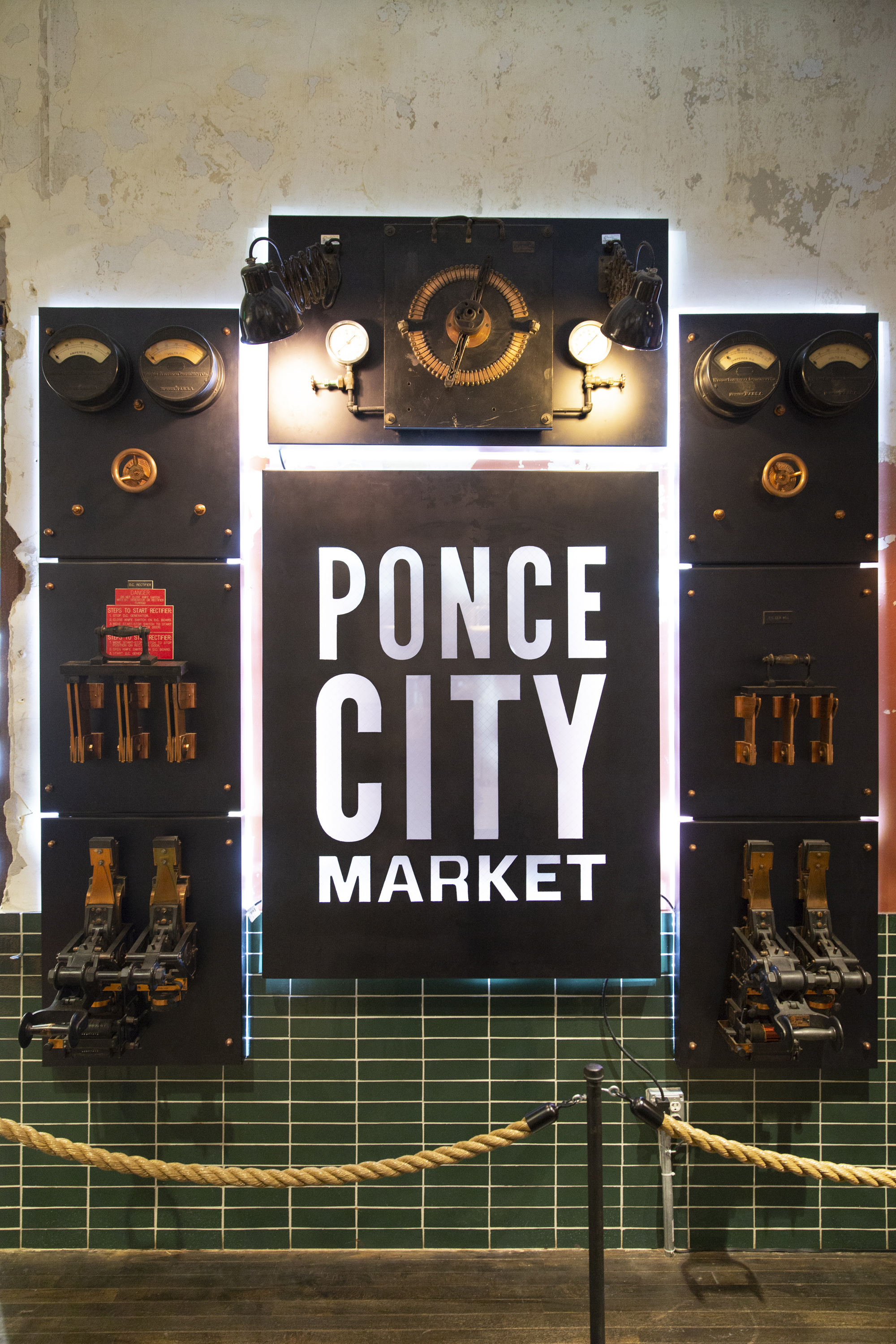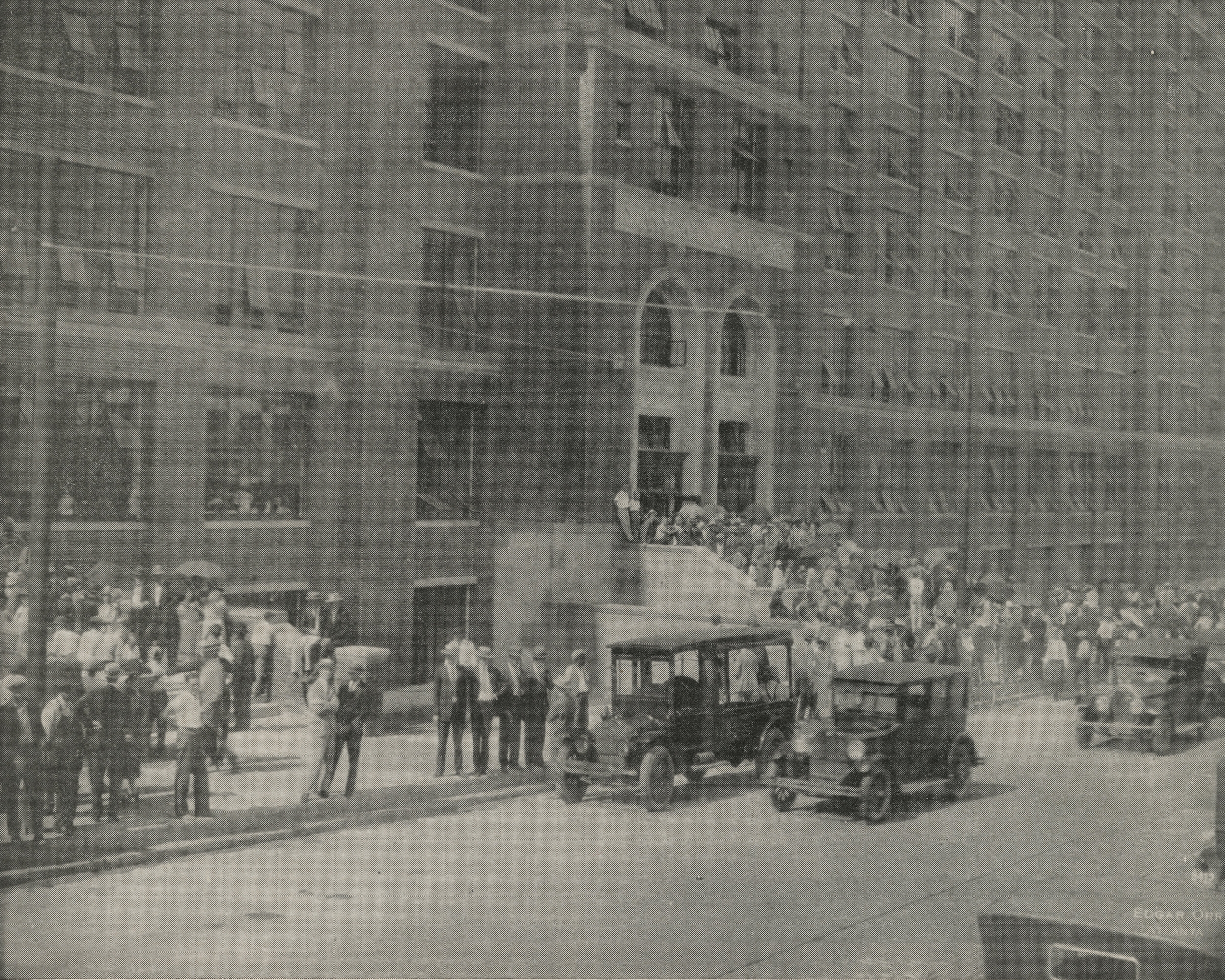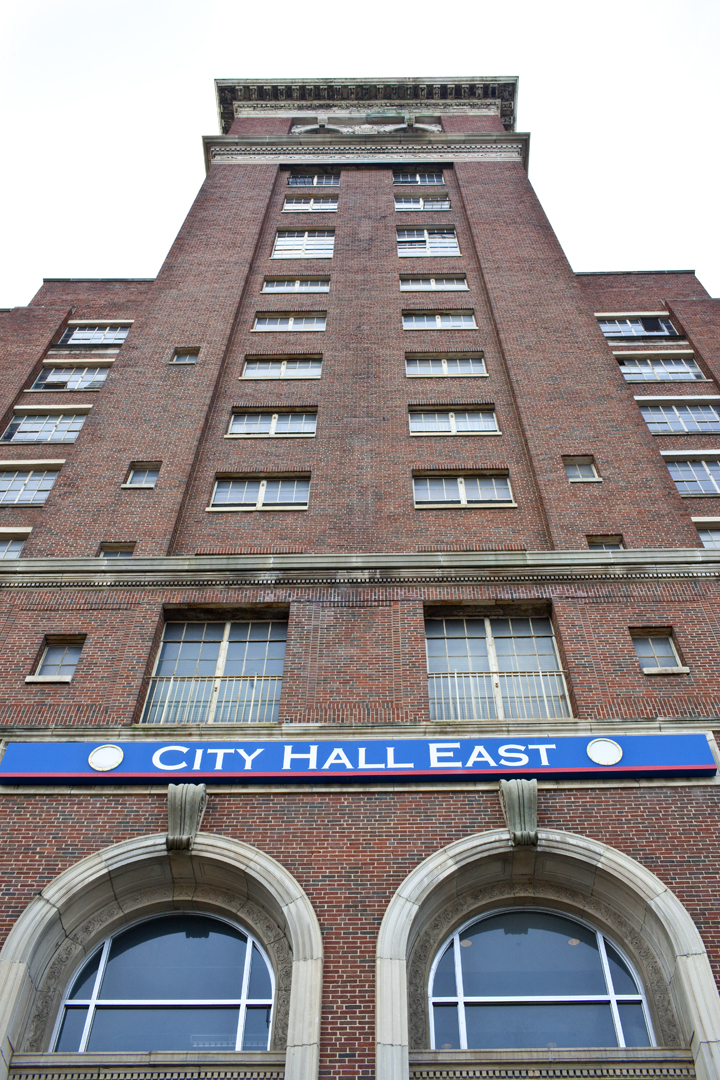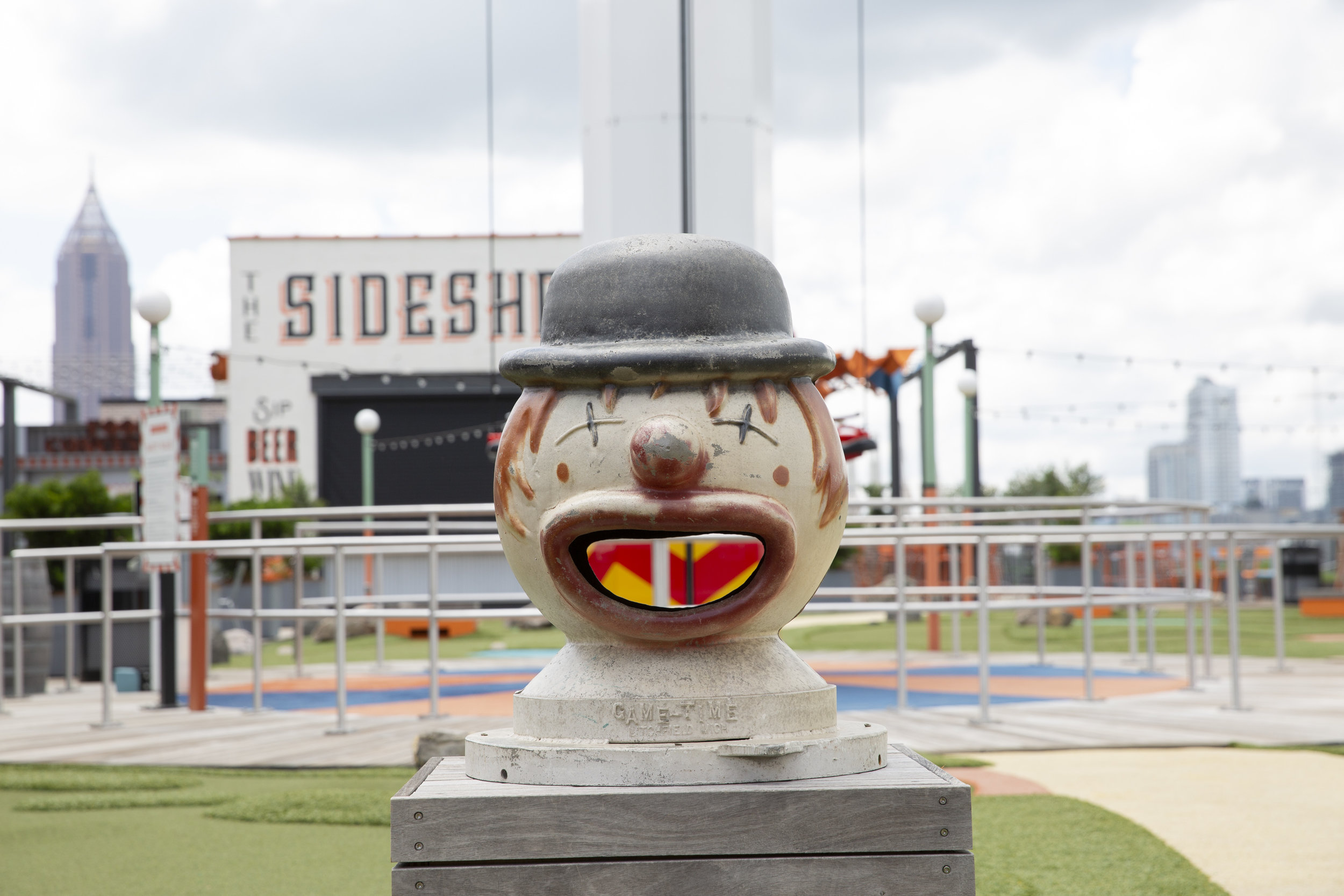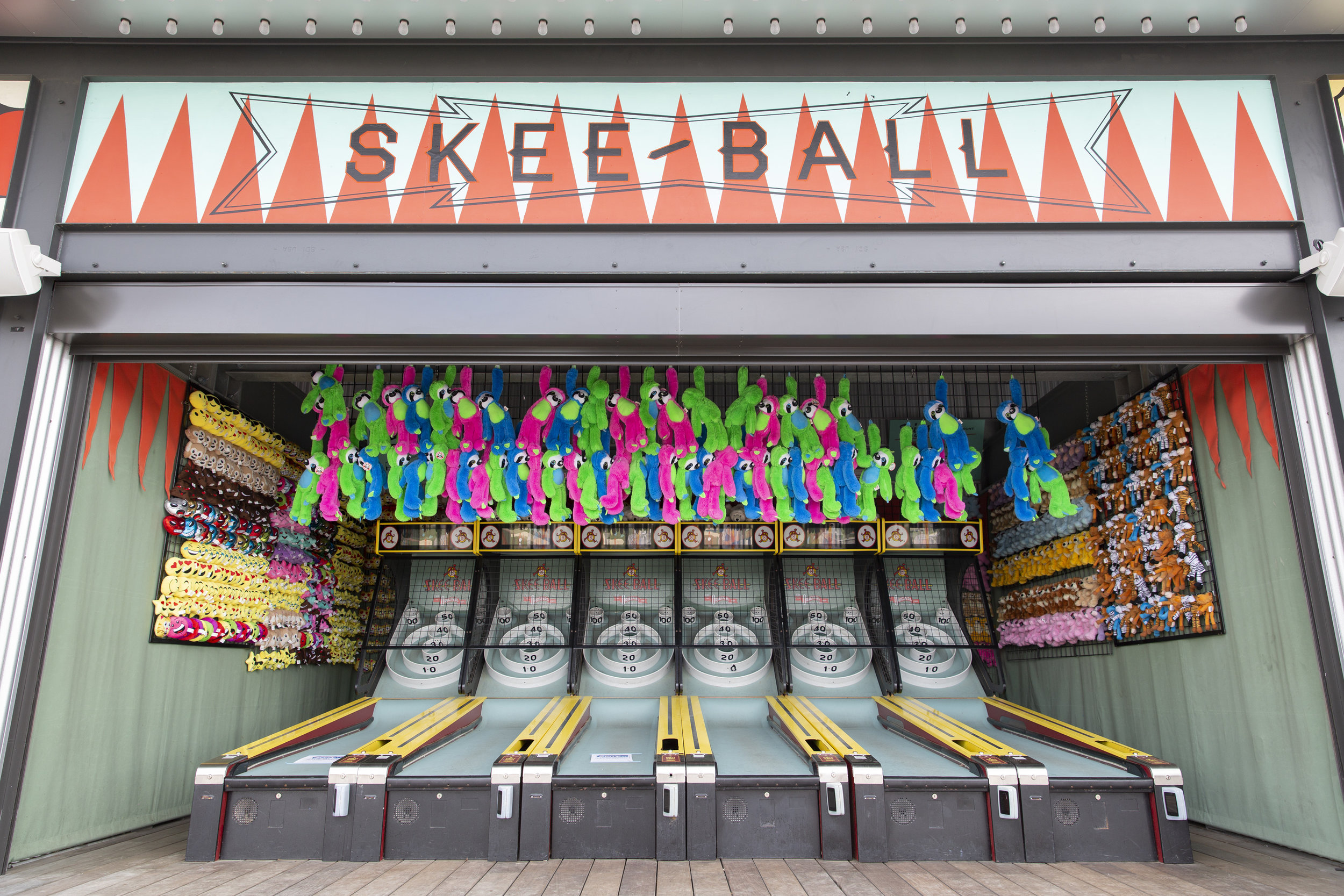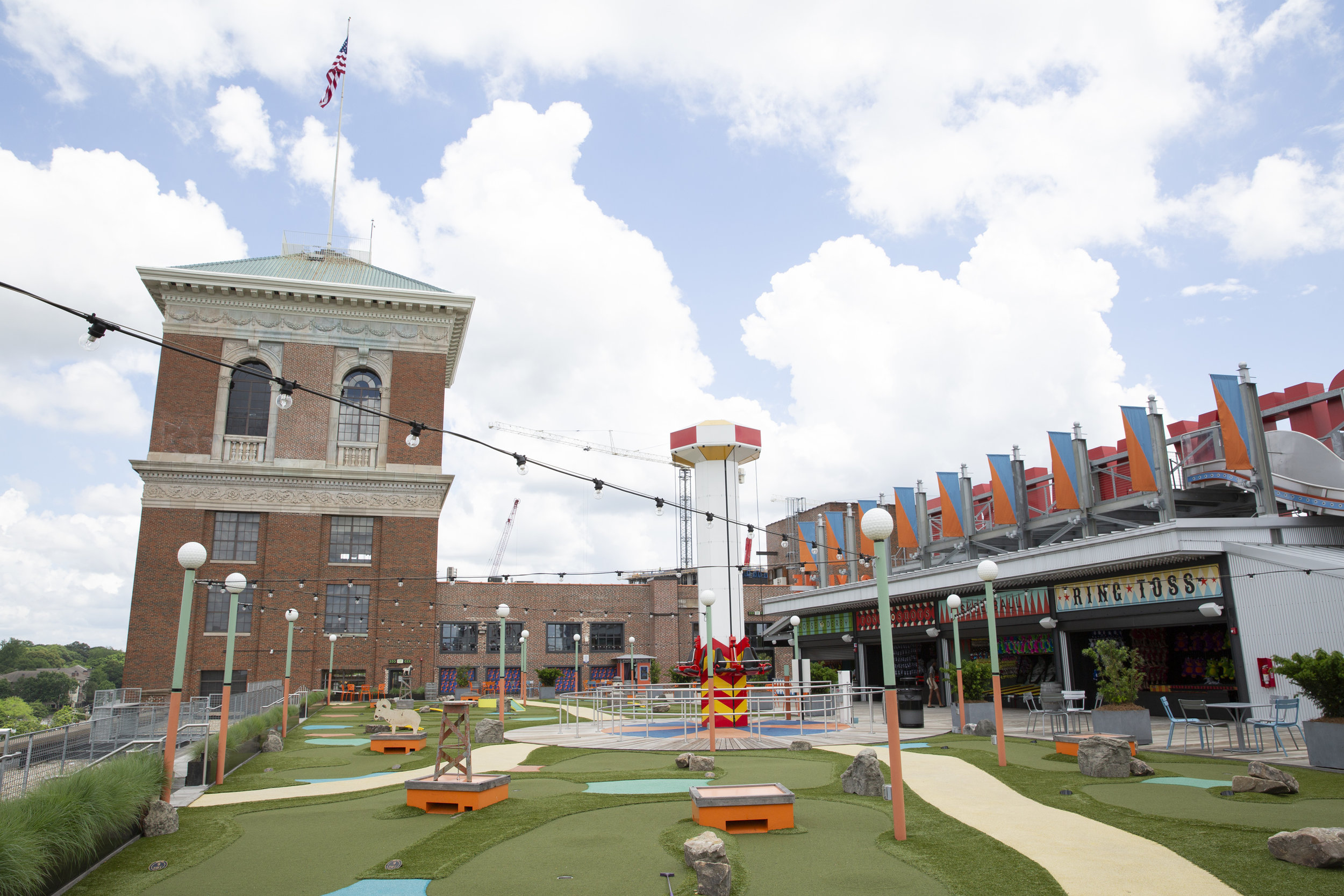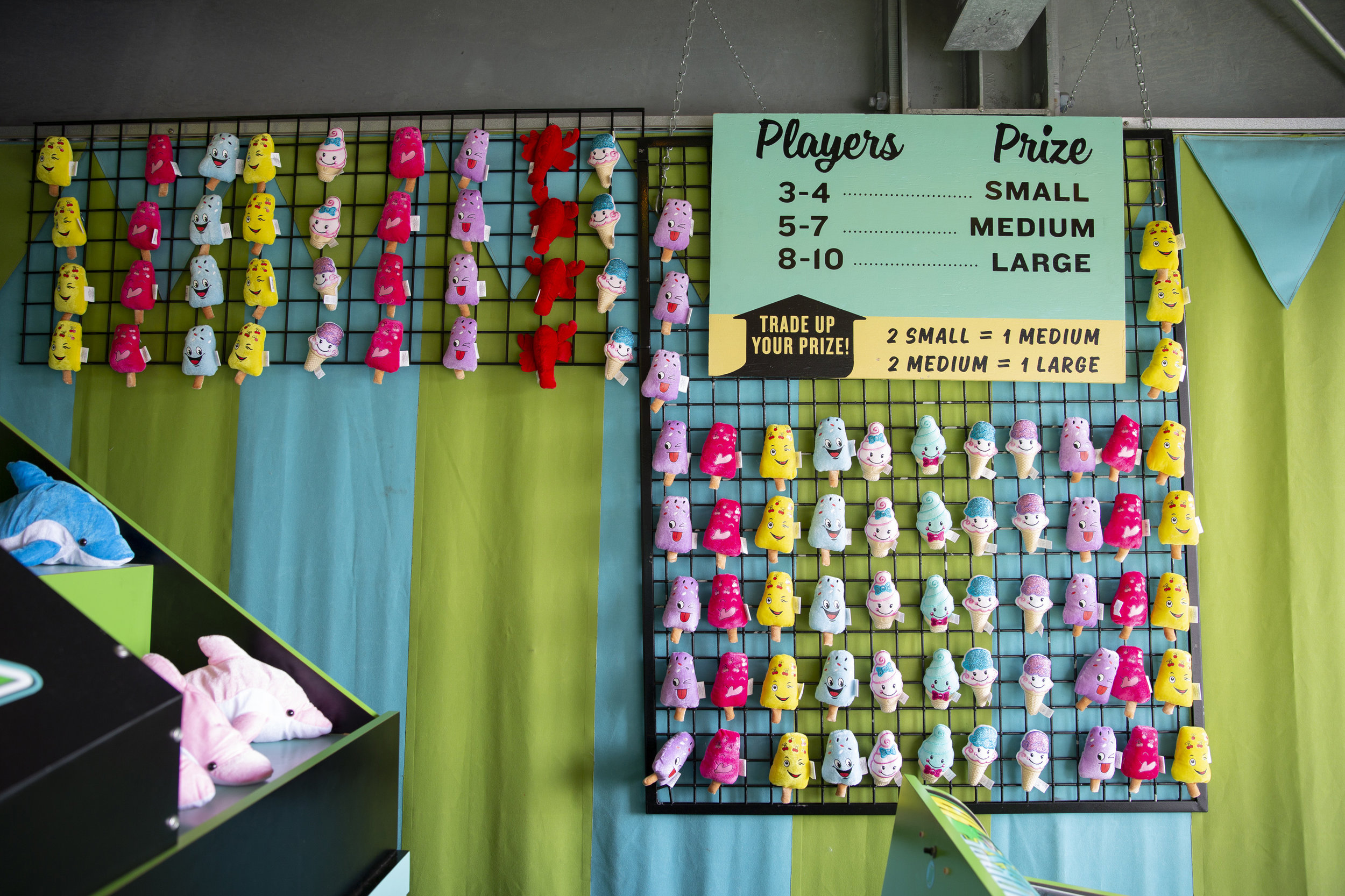A giant old building housing Sears Roebuck used to be the center of everything along Atlanta’s Ponce de Leon Avenue. Then, it lay dormant for nearly a quarter century. Today, it once again teems with Atlantans, who know little of the place’s deep history. Let’s explore what came before.
Story by Jodi Cash | Photographs by Amanda Greene
A young man sits at a piano painted with colorful mosaics, beneath an overhang that connects Ponce City Market to Atlanta’s busy Beltline. As his fingers skillfully caress the keys, he leans his head back and closes his eyes. The walkway echos with the sound of a sonata he’s making up as he goes.
People of all ages, colors, and creeds walk by, and they pause, even if only for a moment, to hear the man play.
Few of those people know they are hearing an echo of the Atlanta of almost a century ago, when this block in the city’s Old Fourth Ward neighborhood was an epicenter of activity and commerce, thanks to the hulking presence of Sears, Roebuck and Co. Its mammoth 2.2-million-square-foot building was where, for just over 60 years, a vast proportion of the South’s quality goods, appliances, and agricultural equipment were sold.
Today, the giant building at 675 Ponce de Leon Ave. is once again a beehive of activity, thanks to its redemption as Ponce City Market. Thousands of people stream through every day to shop, to eat, to work, to create, to exhibit, to gather, to think, to commune. Hundreds live in apartments there.
When the Sears, Roebuck & Co. building was transformed into Ponce City Market, the developers left many historical elements in tact as a tribute.
Atop the building, tourists and locals alike come to enjoy a step back into history, from the neighborhood’s incarnation before it was home to Sears. Aside from seeing one of the best views in Atlanta, it offers a glimpse of what was with Skyline Park, an old-timey amusement park, and Nine Mile Station, a beer garden with craft brews and classic cocktails. Soon, in the tower that is the apex of Ponce City Market, RFD Social will open — a two-story gathering space that will feature The Parlour, a rooftop lobby and bar, and The Roebuck Room, a place for private functions.
But few people in this beehive of activity know how much history lies buried in this building and in the neighborhood around it. And they don’t know the whole story — the one about how a single building can change the arc of history for an entire region, and about how it can change the fortunes of individual lives.
To understand how that happened in Atlanta, you must start with a story from before the Sears building was standing. And that story begins with something every human shares — the wish for eternal life.
In the year 1868, a source of never-ending youth must have sounded appealing to Atlantans. It was only three years after the end of the Civil War, four after Sherman lit the city aflame, and Atlanta was still coated in ashes and flush with reminders of its devastation.
Like so much of the South’s redemption after the war, hope arrived with the rail lines. Two miles east of Atlanta’s center, rail workers were looking for water to drink while laying the Air-Line Railroad. Deep in a grove of beech trees, two bubbling springs surfaced on John Armistead’s estate where they were working. One of the springs had a sulfurous smell, and when two railmen battling sickness drank it and claimed they were cured, a legend was born.
Perhaps it was in the spirit of wishful thinking. Or maybe Atlantans needed something new to believe in, but word spread about the spring with healing properties. Retired doctor Henry Lumpkin Wilson, one of a growing number of visitors to the springs, declared the water had medicinal qualities and dubbed them “Ponce de Leon Springs” after the Spanish explorer Juan Ponce de Leon who legendarily searched for a Fountain of Youth.
In 1871, as lore of the springs grew, Armistead began bottling water from them for delivery around Atlanta. The city drank it up. Atlanta was, after all, a place in need of healing. Meanwhile, others traveled great distances to visit Ponce de Leon Springs. People piled in mule-drawn carriages to the springs every day. Ponce de Leon became a destination — a Victorian spa of sorts.
People spread picnics near the water. They visited to celebrate near fragrant azaleas and to rest beneath magnolias. They came to drink the spring waters for their healing properties. They valued it so much Armistead charged five cents for a taste.
People flocking to the springs caught the attention of Atlanta Street Railroad Company co-founder Richard Peters. He saw an opportunity to grow the Peachtree Street Line eastward to the spring, and did so in 1874, effectively creating what we now know as Ponce de Leon Avenue. The Atlanta Street Railroad Company bought the spring and 30 acres surrounding it. Like many rail companies of the era, Peters knew building attractions was a way to keep business bustling on the Nine-Mile Circle which connected the city’s growing neighborhoods. So, he developed a park. The spring had, until that point, been popular for its natural beauty, but the Atlanta Street Railroad Company refined it. Early additions to the leisurely springs were walking paths, pavilions, picnic tables, and attractions for children. A four-acre lake and a small pond were built. This enticed Atlantans to use the trolley service on the weekends rather than merely on the way to and from work during the week.
Horse and mule-drawn trolley cars brought early Atlantans to Ponce de Leon Springs, which became something of a Victorian spa.
Shortly after the turn of the 20th century, a group of investors bought the park and springs under the name Ponce de Leon Amusement Co. On June 6, 1903, the Ponce de Leon Amusement Company opened to thousands of excited visitors who stepped from the trolley line onto the Coliseum, a grand entrance into the park. There, they found a ferris wheel. A theater hosted the Griffin Comedy Company’s performance to a packed out crowd. There were exotic delights like a Japanese ping-pong parlor, a Gypsy village, the “cave of the winds,” and a laughing gallery. There were tests of skill, like a shooting gallery and knife-throwing boards, a penny arcade, and a pony track. Guests indulged in popcorn, candy, soda, and the offerings of on-site restaurants.
The park was a hit, and it was only broadened and improved over the years that followed, with additions like an ostrich farm and a skating rink.
In 1907, the lake at Ponce de Leon Park was filled to make way for a major incoming attraction: minor league baseball. The Atlanta Crackers played their first game on May 23, 1907. The first stadium held 6,800 fans and was quickly expanded to hold 8,000. Deep in centerfield, a magnolia tree planted in the 1860s remained. And in 1919, Atlanta gained their own Negro Southern League team, the Atlanta Black Crackers.
The east side of the city was bustling, and Atlanta and business minds advocated for more development. In 1925, they launched a “Forward Atlanta” advertising campaign that offered tax breaks to draw national business and highlighted the city’s capable workforce, transit, blossoming economy, and warm weather.
This caught the attention of Sears, Roebuck & Co., the Chicago-based retail giant. Sears bought 16 acres on Ponce in 1925 with plans for a new regional headquarters, but the company was already a fixture in Southern culture.
After the original stadium burned down, it was rebuilt as Spiller Park, where the Atlanta Crackers and Atlanta Black Crackers played from 1924-1965, right across the street from where Sears, Roebuck & Co. opened in 1926.
By 1925, Sears had already charmed the South.
In the severe economic depression that followed the Civil War, there were few opportunities for Southerners to make contact with the broader world. The only places to shop were at overpriced general stores that popped up along the rail lines. Here, choices were limited and prices steep. Quite often, farmers found themselves in crippling debt to the general stores, especially after a failed harvest.
Even worse, carpetbaggers, swindlers, peddlers, and snake-oil salesmen preyed upon the desperate region. They took particular advantage of women tending the house while their husbands worked in the fields or elsewhere.
But soon an alternative arrived — by mail. Richard Sears began sending catalogs when he and his business partner Alvah Roebuck launched in 1892. At that time, they were exclusively selling watches and jewelry.
As Sears, Roebuck & Co. grew, so did the demand and opportunity for mail order commodities. Railroads were extending nationally, alongside the growing postal service. And in 1896, Congress passed the Rural Free Delivery Act, which rolled out to 29 states and mandated free delivery of mail to rural communities. By 1903, it was possible for Sears to send a catalog to every residence on every dirt road in the South.
Richard Sears had an unparalleled ability to sell a product. The man was something of a copywriting mastermind, and his fantastical, carnivalesque aesthetic resonated with Southern people. He also made (and matched) compelling claims about being the cheapest source of farm wares in the country. Sears sold everything from durable farm clothes to tractors to live farm animals, and did so at bargain rates.
But Sears had a vision that went drastically beyond appealing to rural Americans. He knew that if he helped restore bounty in rural America, and especially in the South, he’d increase his customer base profoundly.
“Because it was the neediest part of the country, it became this sort of testing lab for all these programs,” says historian Jerry Hancock.
Historian Jerry Hancock’s whole life has been shaped by Sears. First, it was the source of his favorite childhood belongings. Now it’s the inspiration for his research.
Hancock, a native of South Georgia, found his whole childhood colored by Sears, Roebuck & Co. He’s spent much of his adult life crafting an historical appreciation for the company’s impact on the region.
One of Hancock’s discoveries was Sears’ response to the needs of a rural South in which literacy was rare. For someone who could neither read nor write, placing orders and following written protocols were problematic. Richard Sears responded with a policy that his company would fill any order it received, no matter what the medium or format. So, country folks who were once too daunted to send requests to other purveyors could write in on a scrap of paper, asking humbly for a pair of overalls, size large. And even if it was written in broken English or nearly illegible, the overalls would be shipped.
The accessibility of Sears’s mail order catalog was also radically impactful for black people in the South. For the first time, they had the option to buy the same goods white people could, because the company didn’t discriminate against those shopping by mail.
Sears was building its own equity by encouraging Southern commerce.
Under the leadership of Sears’s second president, Julius Rosenwald, the company began to revitalize and stabilize agriculture in the region. Even before the federal government passed legislation in the 1910s to start agricultural extension agents around the nation to help farmers grow their businesses, “Sears had already done a prototype of the program,” says Hancock.
In 1912, Rosenwald contributed $1 million in the name of Sears, Roebuck & Co. to fund a program that sent extension agents out to farms to teach them new ways of farming commodities other than cotton. For a few hundred years, cotton was the lifeblood of the South, but its long tenure had depleted the soil and crippled the economy. Counties that supported an agent who would go out in the name of diversifying agriculture received $1,000. Two years later, Rosenwald’s program became the government-run agricultural extension program that still exists today.
Perhaps more significantly, Rosenwald began to work in partnership with educator, author, orator, and presidential advisor Booker T. Washington. At Washington’s behest, Rosenwald joined the board of the Tuskegee Institute in 1911, where he used Sears’ growing empire to donate an extraordinary amount of money toward higher education for otherwise disenfranchised black citizens. Rosenwald didn’t stop there: He made donations that funded the establishment of about 5,500 schools for poor, rural black children, who had little access to education. The schools, which came to be known as “Rosenwald Schools,” offered learning to more than 660,000 black students from 1915 to 1932.
Even after Rosenwald’s death in 1932, scholarships were given in his name to the likes of W. E. B. DuBois, Ralph Ellison, and Zora Neale Hurston.
“This, compounded with ease of mail order, strengthened African-American relationships with Sears,” says Hancock. “There was even a myth that Sears and Roebuck were black.”
After a steeper economic downturn in 1920, and the toll it took on farmers nationwide by 1921, Rosenwald launched the Sears Agricultural Foundation in 1923. This program functioned as a mail order county agent — farmers could write in about problems they were having and receive desperately needed help. Improved farming practices became widespread as a result.
Before construction began on Sears’ Atlanta in January of 1926, the company had already established hard-earned trust with its Southern customer base, and returns were robust. A significant portion of their business, much of which was selling agricultural tools and wares, was coming from the South. And a lot of that was from Georgia.
That’s why Rosenwald’s predecessor, Robert E. Wood, chose 675 Ponce de Leon Ave. as the site for a giant retail store and catalog-order fulfillment center. It was a prime location, across the street from where both the white and black Atlanta Crackers played ball, so people were already accustomed to visiting the neighborhood. And even more importantly, the location gave Sears direct access to the railroad.
Construction began in January and proceeded with remarkable speed. The doors opened to a crowd of more than 30,000 people on the first day of business: August 2, 1926. Sears put 1,500 people to work and projected $30 million in annual sales. It even began broadcasting its own radio program aimed at farmers from the tower atop the building. It was called “Dinner Bell R.F.D.”
On opening day in August of 1926, Sears, Roebuck & Co. was visited by more than 30,000 people.
Parker Johnson’s father started working at Sears in Atlanta two years after it opened. He worked as a control buyer for the automotive department (an offshoot of which would later become Allstate Insurance).
“He was there until ’73,” recalls Johnson, who started his own career at Sears a few years before his father retired.
Johnson was drawn into the business not just by his family connection, but also by the familial work culture there.
“It was a family,” he says. “We had good times, and we worked hard.”
Like many Sears employees, Johnson and his father spent most of their lives commuting a long distance to work from their homes in Clarkston. They’d carpool with coworkers, and this only tightened their bonds. It also strengthened the relationship between the urban and rural aspects of the business.
“Sears touched rural America just as much as they did the City of Atlanta,” Johnson says, “because a lot of times that was the only store they could shop at.”
And from the early years at the Atlanta location, Sears remained true to its agricultural base.
For Parker Johnson, the people of Sears were like family.
The tie to farming made Sears appealing to Loretta Stovall. She grew up in the Bill Arp community of Douglasville, Georgia, about 35 miles west of the Sears building. Her daddy was a farmer, and Sears provided the necessities for their family of ten. Although her mother made most of her clothes, she and her siblings looked forward to a new pair of Easter shoes from Sears each year.
She went to work there in 1959 after getting married as a senior in high school a year earlier. She got a job in the credit department while her first husband worked as a mechanic in the auto department.
“It was quite an experience for the girl that had grown up in the country,” she says.
Since her husband kept different hours, she’d ride into town with four other coworkers, two women and two men. Familiar to the tale of life at Sears, they formed close bonds. She felt this throughout her work atmosphere.
“We were just a group of people that enjoyed being together, and that made a lot of difference,” she says.
She worked hard for a $1.05 an hour and was proud of her raise to $1.12.
With money from her job, Stovall purchased life-changing Sears staples: a Kenmore refrigerator and a washer and dryer.
“I thought I had arrived. I really did,” she says. This entrée into modernity was revolutionary for women all over the country. A machine could now accomplish chores that historically took hours.
When Stovall left Sears after three and a half years to have her first child, she did so with a newfound sense of self.
“[I learned] that I was capable of doing anything that I put my mind to — and that I didn't have to feel like that I didn't measure up as a little country girl like we were treated in school,” she says. “It just helped me gain confidence in myself, and that was the main thing, to realize that I could and I was capable of work, and doing a good job. And I took a lot of pride in my work.”
Outside the walls of the Sears building, the South was changing. The Brooklyn Dodgers came to play the Atlanta Crackers in a three-game series in 1949, bringing with them African-American baseball legends Jackie Robinson and Roy Campanella. They were the first two black players to face off against an all-white team in Atlanta.
Despite Rosenwald’s ambitious programs in the 1910s and ’20s, the Atlanta Sears sat atop a racial dividing line between black and white residents. The separation lines are still visible in the differing names of streets north of Ponce de Leon, where white residents lived, and south, where black residents lived. Cross Ponce, and Briarcliff Road becomes Moreland Avenue, Monroe Drive becomes Boulevard, Charles Allen Drive becomes Parkway.
Princess Wilson spent most of her life toeing those racial lines in the Old Fourth Ward. When her mother would take her to Sears to shop for shoes, she was too young to remember any discriminatory treatment. But Sears did follow Jim Crow laws in its Atlanta store, and until integration, black employees were relegated to warehouse, janitorial, and cafeteria jobs.
However, she and her family were permitted to shop there, which can’t be said for every establishment in Atlanta at the time.
“We would go trotting into Sears Roebuck to get our shoes for the year. That was our only place of getting our shoes at that time because certain places we couldn't go to,” she says.
Princess Wilson, a lifelong resident of the Old Fourth Ward, has witnessed drastic changes in her neighborhood.
As the neighborhood progressed, Wilson witnessed memorable changes. She was among the first young black women to attend a white Catholic high school when it integrated in the ’60s. During the Civil Rights Movement, the school’s white nuns took Wilson and fellow black classmates to participate in sit-ins downtown.
As the neighborhood slowly dealt with the impact of integration, Sears’ dominion began to slip. White flight was sending thousands of Atlantans to new homes in the suburbs, and retail trends began changing.
“We really didn’t change that quickly; we were very slow on change,” says former employee Parker Johnson. “Everybody said we were going to reorganize and do this, reorganize and do that, and we wound up doing the same thing over and over again and expecting different results.”
Johnson was at home, sick, on the day Sears announced it would close its operation at 675 Ponce. His boss called him with what he warned would be unbelievable news. Johnson was stunned.
The building where his father had spent 45 years and where he’d spent 20 was going out of commission.
“Everybody’s mouth just fell open, and they didn’t know what to do, because a lot of people had 30 and 40 and 50 years at Sears,” Johnson says. “Their whole life, everything they did revolved around Sears. It was quite heartbreaking to them when they announced the closing and when they closed.”
Sears shut its Ponce de Leon doors for good in 1989.
Two years later, the City of Atlanta bought the building and renamed it City Hall East. But city employees and operations never filled more than 10 percent of the huge building, and the cost of running it was extravagant. In the unused 90 percent of 675 Ponce, the largest brick building in the South, time stood still for more than two decades. The cavernous halls, where thousands of people spent their entire working lives, remained eerily intact. Family photos adorned abandoned desks. Order slips collected in wastebaskets. Time cards marked final shifts.
The building became a destination for vandalism and vagrancy. The Old Fourth Ward was in a similar state of disrepair. Crime was high. Occupancy was low. Opportunities for improvement were few and far between. Then, the 2008 housing market crash devastated Atlanta, and things got worse. The city pulled all its operations out of the building in 2010.
But in a neighborhood where change had been so visible through the middle of the 20th century, urban planners and city officials were beginning to dream of revitalization.
It began with fixing a storm water problem that had been persistent for decades along North Avenue — the street that runs behind the building, parallel to Ponce de Leon. With every heavy rain, the street and surrounding buildings would flood. Old Fourth Ward Park was built to solve the problem. The basin-like park can withstand a 100-year flood, and it provides a needed source of recreation.
Then, the Beltline was developed. As this huge reclamation project began — its ultimate goal being a pedestrian path and a series of parks encircling the entire city — suddenly the old was primed for sale.
In 2011, Jamestown, a real estate investment and management company, came along with a vision for how the building could be restored to its old purposes: a place for work and play — and, as a new feature, a place to live. A plan for Ponce City Market was born.
Yet again, 675 Ponce de Leon is a vibrant destination for visitors and locals alike. It’s been a forerunner for progress in an area that had long endured decline.
When the deal made it onto the table, Kwanza Hall was an Atlanta City Council member whose district included the Old Fourth Ward. Hall’s father was a civil-rights activist and an elected city official, and he influenced his son’s relationship with the building. When Mayor Maynard Jackson was in office, Hall’s family would go to City Hall East during the holiday season to help with the Empty Stocking Fund.
“We would go and help put the bags together for the families and children who were in need. It's kind of like it came all the way full circle for me,” Hall says.
And it did. The development of Ponce City Market, which opened fully in 2014, brought prosperity to the neighborhood beyond what anyone could have imagined.
“It's been a winning proposition, even with the fact that we were carrying an underutilized asset for some period on the city's books, but what it has done as an agent of change, in this part of town, it's no less than phenomenal,” says Hall.
Not only has Ponce City Market, alongside the Beltline and Old Fourth Ward Park, rejuvenated the neighborhood financially, it held onto powerful nostalgia for the building’s history. Jamestown took painstaking efforts to use everything it could from the original facility. It restored the original oak floors, which still bear the grooves worn by thousands of Sears workers and shoppers. It restored 55,000 panes of glass to maintain the original windows. It restored the beautiful brick facade — no small feat considering that it’s the largest brick building in the entire South.
Throughout the building, there are original sinks, clocks, elevators, and the building’s signature columns are visible. Signs and decor point to the building’s colorful history and significance to the region.
Industrialism made leisure possible for the masses, and that metaphor plays out on Ponce City Market’s rooftop development, established in partnership with Slater Hospitality. At Skyline Park, guests play games of old and enjoy the thrills that once endeared this neighborhood to all of Atlanta. And at Nine Mile Station, a reference to the trolley that incited development here originally, people can experience an elevated version of what Atlantans of the Gilded Age loved most: eating, drinking, and lounging.
The literal crowning achievement of Ponce City Market is its rooftop developments — Nine Mile Station and Skyline Park — which nod to the neighborhood’s original causes of development: Ponce de Leon Springs, the trolley line, and the Ponce de Leon Amusement Company.
Jamestown’s decision to highlight the building’s original purpose has done more than earn Ponce City Market a spot on the National Registry of Historic Places, it’s been redemptive for Atlantans whose lives have been inextricably tied to the building for so long.
“It was a feeling of nostalgia to go and see it, and see the way that they had preserved it,” Loretta Stovall says. “I think they did a super job in going in and letting it be, letting the original character show up.”
It’s just as sentimental for Parker Johnson and other Sears retirees, who were among the first to see the renovated building.
“It’s just amazing to go back and remember the halls you walked,” says Johnson. “The building has changed quite a bit, but yet there’s still pieces of it that will always be there.”
Jerry Hancock is particularly equipped to appreciate the building’s nods to its history.
“I think it’s a monument to [Sears’] contribution. It symbolizes so many things,” says Hancock. “The Agricultural Foundation, the Dixie Progress Campaign, the industry, the good will that they did for the people through the public relations, sending farm kids to college, helping train kids to be farmers — all these things that have such a legacy in the South.”
Princess Wilson appreciates the newfound life and freedom Ponce City Market offers her neighborhood, though she hopes to see more outreach to seniors so that other longtime residents embrace it as she does.
“I think with Ponce City Market coming in, it has greatly improved our neighborhood,” she says. “It has changed it tremendously to me.”




